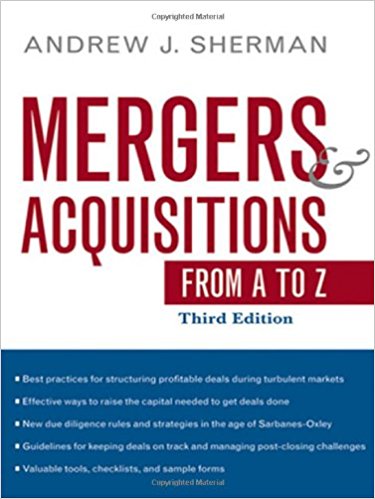
Mergers & Acquisitions From A to Z
Authors: Andrew J. Sherman
Year: 2010
Month: November
Publisher: AMACOM
ISBN: 978-0814413838
Mergers and acquisitions represent a successful growth strategy for many companies, but, while potentially profitable, M&A transactions are complex and often risky. Covering the latest trends, developments, and best practices for the post-Madoff era, this comprehensive, hands-on resource walks readers through every step of the process, offering practical advice for keeping deals on track and ensuring post-closing integration success.
Filled with case studies and war stories illustrating what works and why, the third edition of Mergers and Acquisitions from A to Z offers valuable tools, checklists, and sample documents, providing crucial guidance on: preparing for and initiating the deal; regulatory considerations; due diligence; deal structure; valuation and pricing; and financing even during turbulent market conditions.
M&A transactions can quickly spell a company’s doom if they are not conceived and executed carefully, legally, and sensibly. This is the classic guide to mergers and acquisitions, now completely updated for today’s market.
Table of Contents
ACKNOWLEDGMENTS ix
INTRODUCTION TO THE THIRD EDI T ION xi
CHAPTER 1
The Basics of Mergers and Acquisitions 1
Understanding Key Terms 1
What’s All the Fuss About? 3
Why Bad Deals Happen to Good People 8
Why Do Buyers Buy, and Why Do Sellers Sell? 9
CHAPTER 2
Preparing for the Dance: The Seller’s Perspective 13
Conducting a Thorough EOTB Analysis 17
Preparing for the Sale of the Company 17
Common Preparation Mistakes 29
Other Considerations for the Seller 31
CHAPTER 3
Initiating the Deal: The Buyer’s Perspective 34
Assembling the Team 34
Developing an Acquisition Plan 35
Applying the Criteria: How to Narrow the Field 43
Approaching a Company That Is Not for Sale 44
Dealing with the Seller’s Management Team 45
Directory of M&A Resources for Prospective Buyers (and Sellers) 46
CHAPTER 4
The Letter of Intent and Other Preliminary Matters 51
Proposed Terms 52
Binding Terms 52
Common Reasons Why Deals Die at an Early Stage 59
Preparation of the Work Schedule 60
Another Predeal Task: The Growing Debate About the Role and
Usefulness of Fairness Opinions 61
CHAPTER 5
Due Diligence 65
Best Practices in Due Diligence in the Era of Accountability 2.0 66
Legal Due Diligence 74
Business and Strategic Due Diligence 83
Conclusion 91
Appendix to Chapter 5: Post-Sarbanes-Oxley Due Diligence
Checklist 92
The Disclosure Requirements 93
Checklist of Items Post-Sarbox 97
CHAPTER 6
An Overview of Regulatory Considerations 101
Introduction 101
Environmental Laws 102
Federal Securities Laws 103
Federal Antitrust Laws 106
Waiting Periods 109
Labor and Employment Law 113
CHAPTER 7
Structuring the Deal 120
Stock vs. Asset Purchases 122
Tax and Accounting Issues Affecting the Structure of the
Transaction 126
One-Step vs. Staged Transactions 130
Method of Payment 132
Nontraditional Structures and Strategies 135
CHAPTER 8
Valuation and Pricing of the Seller’s Company 144
A Quick Introduction to Pricing 146
Valuation Overview 147
CHAPTER 9
Financing the Acquisition 155
An Overview of Financing Sources 156
Understanding the Lender’s Perspective 159
Financing Deals in Times of Turmoil 160
Steps in the Loan Process 164
Equity Financing 168
CHAPTER 10
The Purchase Agreement and Related Legal Documents 189
Case Study: GCC Acquires TCI 191
Sample Schedule of Documents to Be Exchanged at a Typical
Closing 209
CHAPTER 11
Keeping M&A Deals on Track: Managing the Deal Killers 252
Communication and Leadership 253
Diagnosing the Source of the Problem 254
Understanding the Types of Deal Killers 254
Curing the Transactional Patient 256
Maintaining Order in the M&A Process: Simple Principles for
Keeping Deals on Track 257
Conclusion 258
CHAPTER 12
Postclosing Challenges 259
A Time of Transition 260
Staffing Levels and Related Human Resources Challenges 264
Customers 267
Vendors 268
Physical Facilities 268
Problems Involving Attitudes and Corporate Culture 269
Benefit and Compensation Plans 271
Corporate Identity 272
Legal Issues 272
Minimizing the Barriers to the Transition 273
Postmerger Integration Key Lessons and Best Practices 277
Conclusion 280
CHAPTER 13
Alternatives to Mergers and Acquisitions 281
Growth Strategy Alternative 1: Joint Ventures 282
Growth Strategy Alternative 2: Franchising 287
Growth Strategy Alternative 3: Technology and Merchandise
Licensing 299
Growth Strategy Alternative 4: Distributorships and Dealerships 306
INDEX 309
